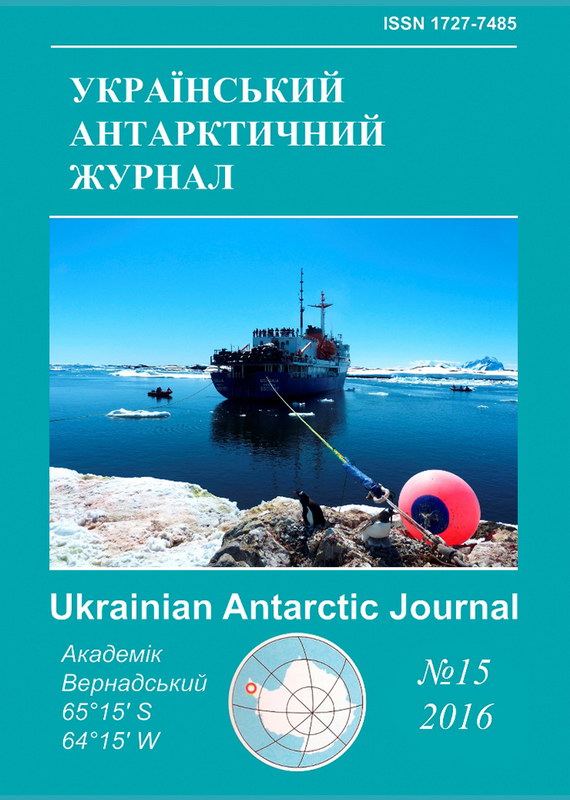Diversity of Antarctic microorganisms - potential producers of biologically active substances
- Antarctic microorganisms,
- collection of technologically advanced microorganisms

This work is licensed under a Creative Commons Attribution-NonCommercial-NoDerivatives 4.0 International License.
Abstract
Search for new producers of biologically active compounds that can be widely used in various fields of human activity is intense among the variety of organisms, habitats of which are connected with the extreme conditions of existence, including Antarctica. The purpose of this work was conducting relevant research on this topical issue. 25 isolation of pure cultures of microscopic fungi (species of Mortiriella, Mucor, Eurotium, Cladosporium, Fusarium, Geotrichum, Pseudogymnoascus, Penicillium, Phoma, Rhodotorula etc.) were obtained from the samples of mosses, lichens, soil and stones obtained from 18-20th Ukrainian Antarctic expedition (Galindez, Pitterman and Yalur Islands). Among them Pseudogymnoascus pannorum and Mucor circinelloides are characterized by a pronounced activity to the synthesis of complex of biologically active lipids. 8 pure cultures of bacteria were also isolated that synthesize biologically active substances which can inhibit the growth of other microorganisms (pronounced antagonistic properties were observed). Collection of technologically advanced microorganisms replenished whith new srains of microscopic fungi and bacteria - producers of biologically active compounds.
References
- Antipova, T. V. (2009). Shtammy-relikty gribov roda Penicillium kak produtsenty vtorichnykh metabolitov [Relic strains of Penicillium fungi as producers of secondary metabolites]. Avtoref. dis. k.b.n. (in Russian)
- Feofilova, E. P. (2007). Novye biotekhnologii polucheniia biologicheski aktivnykh veshchestv iz mitselial’nykh gribov [New biotechnologies of obtaining bioactive substances from mycelial fungi]. Uspekhi meditsinskoi mikologii, ІХ, 195-196. (in Russian)
- Tkachevskaia, E. P., Konova, I. V., Sergeeva, Ya. S. et al. (2007). Novye napravlenia prakticheskogo ispol’zovania oleagennykh gribnykh mikroorganizmov (r. Cuningamella i dr.) v poluchenii biodizelia i dlia modifikatsii sinteticheskikh polimerov [Novel approaches of practical application of oleagenic fungal microorganisms (Cuningamella and other genera) for biodiesel production and for modification of synthetic polymers]. Uspekhi meditsinskoi mikologii, ІХ, 190-194. (in Russian)
- Ali, S., Hameed, S., Imran, A. et al. (2014). Genetic, psychological and biochemical characterization of Bacillus sp. strain RMB7 exhibiting plant growth promoting and broad spectrum antifungal activities. Microb. Cell Fact., 13, 144-159.
- Asencio, G., Lavin, P., Alegria, K. et al. (2014). Antibacterial activity of the Antarctic bacterium Janthinobacterium sp. SMN 33.6 against multi-resistant Gram-negative bacteria. Electron. J. Biotechnol., 17(1), 1-5.
- Bhanja, A., Minde, G., Magdum, S., Kalyanraman, V. (2014). Comparative studies of oleaginous fungal strains (Mucor circinelloides and Trichoderma reesei) for effective wastewater treatment and bio-oil production. Biotechnol. Res. Int., 2014, 1-7.
- Henriquez, M., Chaves, R., Vaga, I. 2013. Antarctic fungi: Sources of new chemical substances with antibacterial properties. Chilean Antarctic Bulletin, 13(1-2), 12
- Jagannadham, M. V., Chattopadhyay, M. K., Subbalakshmi, C. et al. (2000). Carotenoids of an Antarctic psychrotolerant bacterium, Sphingobacterium antarcticus, and a mesophilic bacterium, Sphingobacterium multivorum. Arch. Microbiol., 173(5-6), 418-424.
- Kaneshiro, T., Nakamura, L. K., Bagby, M. O. (1996). Oleic acid transformations by selected strains of Sphingobacterium thalpophilum and Bacillus cereus from composted manure. Current microbiology, 31(1), 62-67.
- Konova, I. V., Sergeeva, Ia. E., Galanina, L. A. et al. (2009). Lipid synthesis by Geomyces pannorum under the impact of stress factors. Mikrobiologiia, 78(1), 52-58.
- Kostadinova, N., Krumova, E., Tosi, S. et al. (2009). Isolation and Identification of Filamentous Fungi from Island Livingston, Antarctica. Biotechnology and Biotechnological Equipment, Special Issue: XI Anniversary scientific conference, 23, Supplement 1, 267-270.
- Margesin, R., Fauster, V., Fonteyne, P. A. (2005). Characterization of cold-active pectate lyases from psychrophilic Mrakia frigida. Lett. Appl. Microbiol., 40(6), 453-459.
- Nai, C., Wong, H. Y., Pannenbecker, A. et al. (2013). Nutritional physiology of a rock-inhabiting, model microcolonial fungus from an ancestral lineage of the Chaetothyriales (Ascomycetes). Fungal Genet. Biol., 56, 54-66.
- Papa, R., Parrilli, E., Sannino, F. et al. (2013). Anti-biofilm activity of the Antarctic marine bacterium Pseudoalteromonas haloplanktis TAC125. Res. Microbil., 164(5), 450-456.
- Poli Annartia, Anzelmo Gianluca, Nicolaus Barbara. (2010). Bacterial Exopolysaccharides from Extreme Marine Habitats: Production, Characterization and Biological Activities. Mar Drugs. 8(6), 1779-1802.
- Roberto Paul Anitori. (2012). Extremophiles: Microbiology and Biotechnology.
- Samson, R. A., Hoekstra, E. S., Frisvad, J. C. (2004). Introduction to food and airborne fungi. 7th edit. Wageningen, the Netherlands, printed by Ponsen and Looyen.
- Svahn, S. K., Olsen, B., Bohlin, L. et al. (2015). Penicillum nalgiovense Laxa isolated from Antarctica is a new source of the antifungal metabolite amphotericin B. Fungal Biology and Biotechnology, 1, 2-11.
- Tauk-Tornisielo, S. M., Arasato, L. S., de Almeida, A. F. et al. (2009). Lipid formation and γ-linolenic acid production by Mucor circinelloides and Rhizopus sp., grown on vegetable oil. Brazilian Journal of Microbiology, 40, 342-345.

